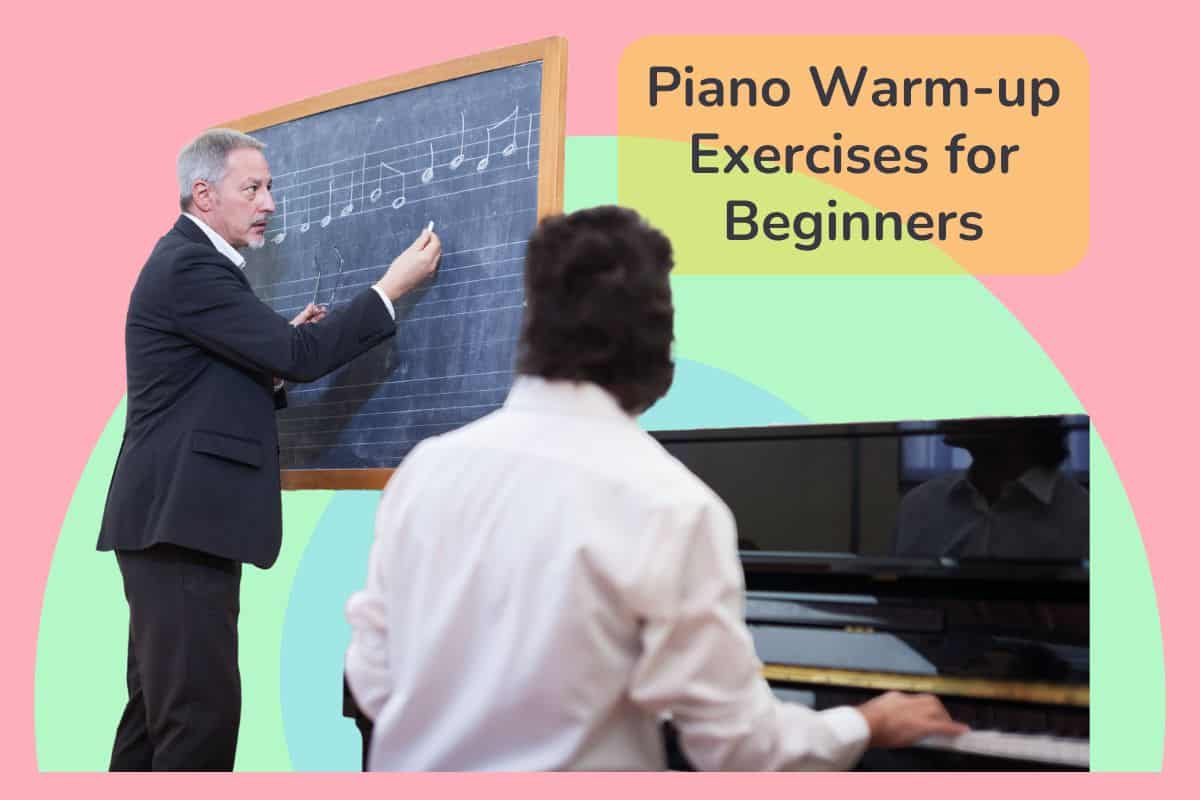Starting to learn the piano is like any new skill; it requires a solid base upon which to build. One of the first things you’ll encounter on this path is the importance of warm-ups. These aren’t just simple exercises; they’re the foundation for developing finger strength, dexterity, and the muscle memory necessary for more complex pieces.

Basics of Piano Warm-Ups
Importance of Warming Up
Warming up before piano practice is not just a recommendation; it’s necessary for your progression and health. Engaging in warm-up exercises primes your fingers, hands, and even your brain for the intricate work of playing music. These exercises enhance your dexterity and coordination, paving the way for a productive practice session.
Anatomy of Hand Muscles and Prevention of Injuries
Your hands are a complex system of muscles, tendons, and nerves. When you’re playing the piano, you’re using parts of your hands and arms that require fine motor skills. Regular warm-up routines not only prepare your fingers for the demands of piano playing but also help prevent common injuries like tendinitis and carpal tunnel syndrome. By incorporating stretches and gentle movements, you ensure that your wrists, back, shoulders, and neck don’t bear undue stress.
Setting Up Your Practice Space
The environment where you practice can significantly affect your ability to warm up properly. Your piano bench should be at a height that allows your forearms to be parallel to the floor when playing. Your back should be straight, and your feet should rest flat on the floor or on a footstool. A well-organized and comfortable practice space reduces distractions and lets you focus solely on your warm-up exercises.
Physical Preparation Before Playing
To get the most out of your practice sessions and minimize the risk of injury, it’s essential to properly warm up your body, focusing on areas like your shoulders, back, neck, and particularly your hands and fingers.
General Stretching Techniques
Before you even touch the piano keys, take a few minutes to perform some general stretches. You’ll want to loosen up your shoulders by gently rolling them forward and backward. You can also alleviate tension in your neck by tilting your head from side to side carefully, and in your back with a few forward bends. This routine helps prevent stiffness during your practice.
Shoulder Rolls:
- Forward: 5 times
- Backward: 5 times
Neck Tilts:
- Left: Hold for 5 seconds
- Right: Hold for 5 seconds
- Forward: Hold for 5 seconds
- Backward: Hold for 5 seconds
Back Stretches:
- Stand up straight, hands on hips.
- Gently lean backward, hold for 10 seconds.
- Bend forward, touching your toes, hold for 10 seconds.
Posture and Hand Positioning
Having the right posture is crucial when playing the piano. Sit with your back straight and feet flat on the floor. Your elbows should be slightly higher than the keys with forearms parallel to the floor.
Posture checklist:
- Back straight, not rigid.
- Feet flat and firm on the ground.
- Elbows just above keyboard level.
For your hands and fingers, start with some finger stretches to improve dexterity. Spread your fingers wide, then make a gentle fist, repeating a few times. Then, practice wrist flexibility by extending your right hand out, palm down, and using the left hand to lightly press down on the fingers, enhancing the stretch, then switch hands.
Finger Stretches:
- Spread fingers wide, hold for 3 seconds.
- Gentle fist, hold for 3 seconds.
- Repeat 5 times.
Wrist Flexibility:
- Right hand out, press down with left hand, hold for 5 seconds.
- Left hand out, press down with right hand, hold for 5 seconds.
- Repeat 3 times for each hand.
Technical Exercises for Building Skills
To enhance your piano playing, focus on exercises that develop finger strength, speed, and independence, as well as your grasp on scales, chords, and rhythm.
Finger Strength and Flexibility Exercises
Start with simple finger patterns that increase your finger strength and flexibility. Practice pressing the keys with deliberate and firm motions, gradually increasing the speed as your fingers become stronger. Utilize exercises like:
- Hanon exercises: Ideal for building strength and dexterity
- Czerny exercises: Focus on finger independence and agility
Scale and Arpeggio Practice
Regular practice of scales and arpeggios lays the foundation for dexterity and familiarity with the keyboard layout. Begin with:
- C Major Scale: Learn both one and two octaves scales using a slow tempo to start
- Arpeggios: Start with C Major and A Minor to build up hand coordination and speed
Chord and Progression Drills
Understanding chords and chord progressions is crucial for pianists. Work on:
- Basic Chords: Aim for clarity and strength in each staccato and legato chord
- Chord Progressions: Practice common progressions in various keys to improve harmonic understanding
Rhythmic and Timing Exercises
Rhythm is an essential element of music. Enhance your timing and rhythm by:
- Metronome Use: Practice scales, arpeggios, and passages to a metronome to improve your internal sense of rhythm
- Rhythmic Patterns: Clap and play various rhythms to increase your rhythmic accuracy
Musical Pieces and Genres
In beginning your piano journey, it’s essential to engage with a variety of music pieces and genres. This exposure not only enriches your understanding of music theory but also sharpens your sight-reading skills and expands your repertoire.
Simple Repertoire for Beginners
When starting out, simplicity is key. Begin with pieces that allow you to focus on learning the basic elements of music without overwhelming you. Here’s a brief list of recommended simple pieces:
- Bach’s Minuet in G: Perfect for understanding music theory basics.
- Twinkle Twinkle Little Star: A familiar tune to practice sight-reading.
- Kuhlau’s Sonatina Op. 20, No. 1: Introduces classical forms at a manageable difficulty.
Exploring Various Musical Genres
Dive into different genres to discover what resonates with you. Each genre presents unique challenges and skills to develop. Here’s a quick look:
- Classical: Try a simple Chopin prelude instead of a ballad to appreciate the genre’s intricacies without the initial complexity.
- Pop: Learning a pop song can be a fun way to apply chords and progressions common in pop music.
- Jazz: It introduces swing rhythm and improvisation which is great for expanding your musicality.
The key is variety; by playing across genres, you’ll become a versatile pianist and find personal favorites along the way.
Advanced Warm-Up Techniques
Don’t neglect advanced warm-up techniques that develop your technical skills and enhance musicality. These exercises are tailored to challenge you while also preparing your hands for more complex piano pieces.
Hanon and Czerny Exercises
Hanon exercises are designed to improve your finger strength and independence, which are crucial for advanced piano performance. Hanon’s “The Virtuoso Pianist” contains 60 exercises, starting with simpler patterns and progressing to more complex maneuvers. Begin with Exercise No. 1, focusing on evenness and control, and gradually increase the tempo only when you’re comfortable.
Czerny exercises, on the other hand, emphasize musical expression alongside technical proficiency. Czerny’s “School of Velocity” offers a collection of studies that target specific skills. For example, you can work on your legato and staccato playing or refine your finger agility across the keyboard. Practice each exercise slowly at first, paying close attention to articulation and dynamics.
Integration of Improvisation
Improvisation isn’t solely a jazz concept; it’s a valuable skill for classical pianists as well. Integrating improvisation into your warm-up exercises can enhance your creativity and spontaneity at the keys. Start by picking a key and improvising with scales, arpeggios, or chord progressions. Ensure you use a variety of rhythms and explore different registers of the piano.
You can also improvise over a common chord progression, like the II-V-I, to familiarize yourself with the way different harmonies sound and feel under your fingers. This exercise not only warms up your hands but also sharpens your ear and prepares you mentally for the practice session ahead.
Developing Practice Routines
Your practice routine is crucial for fostering steady progress and ensuring that your fingers become agile and your playing becomes more confident.
Creating a Balanced Practice Schedule
Start by allocating specific times for different exercises. Piano warm-ups should be the first thing you do when you sit at the piano. Begin with simple five-finger scales in C position to wake up your fingers and establish finger independence. Always include a finger stretch to prevent strain as you play. Spend a few minutes here before moving on to practicing songs and techniques.
- Monday, Wednesday, Friday:
-
- 10 minutes of warm-ups (include finger dexterity exercises)
- 20 minutes of song practice
- 10 minutes of new material
- Tuesday, Thursday:
-
- 10 minutes warming-up (focus on staccato arpeggios and broken chords)
- 15 minutes of song revision
- 15 minutes of technical exercises (like scales and thumb tuck)
Don’t forget to rotate between white keys and black keys to familiarize yourself with the differences in touch and spacing.
Incorporating Revision and Commission
In each practice session, make sure you’re reviewing material you’ve previously learned (revision) and adding new pieces or exercises (commission). For balanced growth, try practicing finger independence with exercises that require different actions from each finger. Challenge your thumb tuck and finger stretch abilities to ensure smooth transitions across middle C and beyond. Your daily practice should look something like this:
- 15 minutes: Warm-up exercises (key-based finger dexterity, five-finger scale)
- 10 minutes: Review yesterday’s material
- 20 minutes: Work on new pieces or techniques (the commission part of your routine)
Your warm-up routine should be a tailored experience that sets the tone for your practice session while ensuring your fingers and hands are prepped for playing.




